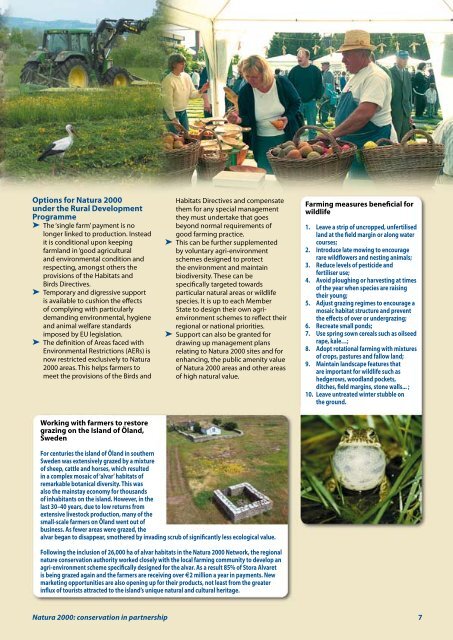00 800 6 7 8 9 10 11 - European Commission - Europa
00 800 6 7 8 9 10 11 - European Commission - Europa
00 800 6 7 8 9 10 11 - European Commission - Europa
You also want an ePaper? Increase the reach of your titles
YUMPU automatically turns print PDFs into web optimized ePapers that Google loves.
Options for Natura 2<strong>00</strong>0<br />
under the Rural Development<br />
Programme<br />
➤ The ‘single farm’ payment is no<br />
longer linked to production. Instead<br />
it is conditional upon keeping<br />
farmland in ‘good agricultural<br />
and environmental condition and<br />
respecting, amongst others the<br />
provisions of the Habitats and<br />
Birds Directives.<br />
➤ Temporary and digressive support<br />
is available to cushion the effects<br />
of complying with particularly<br />
demanding environmental, hygiene<br />
and animal welfare standards<br />
imposed by EU legislation.<br />
➤ The definition of Areas faced with<br />
Environmental Restrictions (AERs) is<br />
now restricted exclusively to Natura<br />
2<strong>00</strong>0 areas. This helps farmers to<br />
meet the provisions of the Birds and<br />
Habitats Directives and compensate<br />
them for any special management<br />
they must undertake that goes<br />
beyond normal requirements of<br />
good farming practice.<br />
➤ This can be further supplemented<br />
by voluntary agri-environment<br />
schemes designed to protect<br />
the environment and maintain<br />
biodiversity. These can be<br />
specifically targeted towards<br />
particular natural areas or wildlife<br />
species. It is up to each Member<br />
State to design their own agrienvironment<br />
schemes to reflect their<br />
regional or national priorities.<br />
➤ Support can also be granted for<br />
drawing up management plans<br />
relating to Natura 2<strong>00</strong>0 sites and for<br />
enhancing, the public amenity value<br />
of Natura 2<strong>00</strong>0 areas and other areas<br />
of high natural value.<br />
Farming measures beneficial for<br />
wildlife<br />
1. Leave a strip of uncropped, unfertilised<br />
land at the field margin or along water<br />
courses;<br />
2. Introduce late mowing to encourage<br />
rare wildflowers and nesting animals;<br />
3. Reduce levels of pesticide and<br />
fertiliser use;<br />
4. Avoid ploughing or harvesting at times<br />
of the year when species are raising<br />
their young;<br />
5. Adjust grazing regimes to encourage a<br />
mosaic habitat structure and prevent<br />
the effects of over or undergrazing;<br />
6. Recreate small ponds;<br />
7. Use spring sown cereals such as oilseed<br />
rape, kale…;<br />
8. Adopt rotational farming with mixtures<br />
of crops, pastures and fallow land;<br />
9. Maintain landscape features that<br />
are important for wildlife such as<br />
hedgerows, woodland pockets,<br />
ditches, field margins, stone walls... ;<br />
<strong>10</strong>. Leave untreated winter stubble on<br />
the ground.<br />
Working with farmers to restore<br />
grazing on the Island of Öland,<br />
Sweden<br />
For centuries the island of Öland in southern<br />
Sweden was extensively grazed by a mixture<br />
of sheep, cattle and horses, which resulted<br />
in a complex mosaic of ‘alvar’ habitats of<br />
remarkable botanical diversity. This was<br />
also the mainstay economy for thousands<br />
of inhabitants on the island. However, in the<br />
last 30–40 years, due to low returns from<br />
extensive livestock production, many of the<br />
small-scale farmers on Öland went out of<br />
business. As fewer areas were grazed, the<br />
alvar began to disappear, smothered by invading scrub of significantly less ecological value.<br />
Following the inclusion of 26,<strong>00</strong>0 ha of alvar habitats in the Natura 2<strong>00</strong>0 Network, the regional<br />
nature conservation authority worked closely with the local farming community to develop an<br />
agri-environment scheme specifically designed for the alvar. As a result 85% of Stora Alvaret<br />
is being grazed again and the farmers are receiving over €2 million a year in payments. New<br />
marketing opportunities are also opening up for their products, not least from the greater<br />
influx of tourists attracted to the island’s unique natural and cultural heritage.<br />
Natura 2<strong>00</strong>0: conservation in partnership<br />
7

















